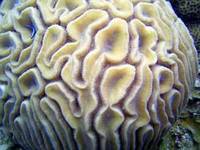March 20, 2005
Day 4 at Cayos Cochinos. Sunday, March 20th 2005
We never know what the weather will be like. Yesterday afternoon was clear but windy; the night was more calm. Most of the activities we have planned at Cayos Cochinos depend on the weather we have.
Today we are diving at Mariposales and looking for an airplane that crashed here – fortunately no one was hurt. Now the plane may serve as a refuge for various marine species.
We find queen conch, which have been severely overexploited and are now protected in some areas of the Caribbean. We also see our first scorpionfish (Scorpaena plumieri) as well as a barred hamlet (Hypoplectrus puella), many bluehead wrasse (Thalassoma bifasciatum) of all colors and ages, and tiny cleaning gobies (Gobiosoma spp.) above the brain coral. And in the sand appear the heads of a few garden eels (Heteroconger longissimus).

Unfortunately, though we spend more than twenty minutes trying to find the airplane, we don’t. We return to the base, arrive in time to eat, and the rest of the Ranger crew arrives to Cayo Menor. Today we all enjoy a meal together.
In the afternoon we prepare for a beach cleaning. Because of the cold front and the winds which have been blowing from both directions in the last few days, large quantities of plastics, bottles, shoes, cans, sandals, rags and even syringes – some of them with needles – have amassed on the beaches of Cochino Menor. Getting to some of these beaches by land isn’t easy. It takes us more than an hour, and we take advantage of the trek to delight in the forest that surrounds the trails. Almost at the summit of the Key, we can observe on either side of the small pass through the undergrowth the contrast with the motley windy zone, where nothing grows beneath the crowns of the trees. Only the sunlight survives in the wind. The regeneration of this part of the forest is very difficult because of the scarcity of nutrients in the soil and the force of the winds. On the other side of the pass, however, where the descent begins, we look down on a spectacular forest with a lush understory. Even the same species of trees grow much taller, their branches are larger and their leaves more abundant.
With six people cleaning for approximately 40 minutes, we fill more than eight large trash bags. The sad truth: glass, iron and other spilled material sink to the bottom because of their weight, paper disintegrates little by little, many of the contaminants that make their way to the sea are invisible, but plastics and soda cans are harder to hide. It is an irrefutable proof of the lack of consideration and respect that persists even today; some people still think of the ocean as a massive trash can.
The impact of human activity, including across great distances, is important. These beaches are nesting sites for endangered hawksbill turtles (Eretmochelys imbricata). Imagine a sea turtle trying to lay her eggs on a beach covered in cans, plastics, and other trash.
This area has been affected by natural disturbances like hurricanes and the warming of surface ocean waters resulting from global climate change. This phenomenon provokes coral bleaching, leaving the coral dead.
Exhausted, we return with our enormous bags of trash to the base camp, hoping that the next visitors will find the paradise the Cochino Menor truly is.

